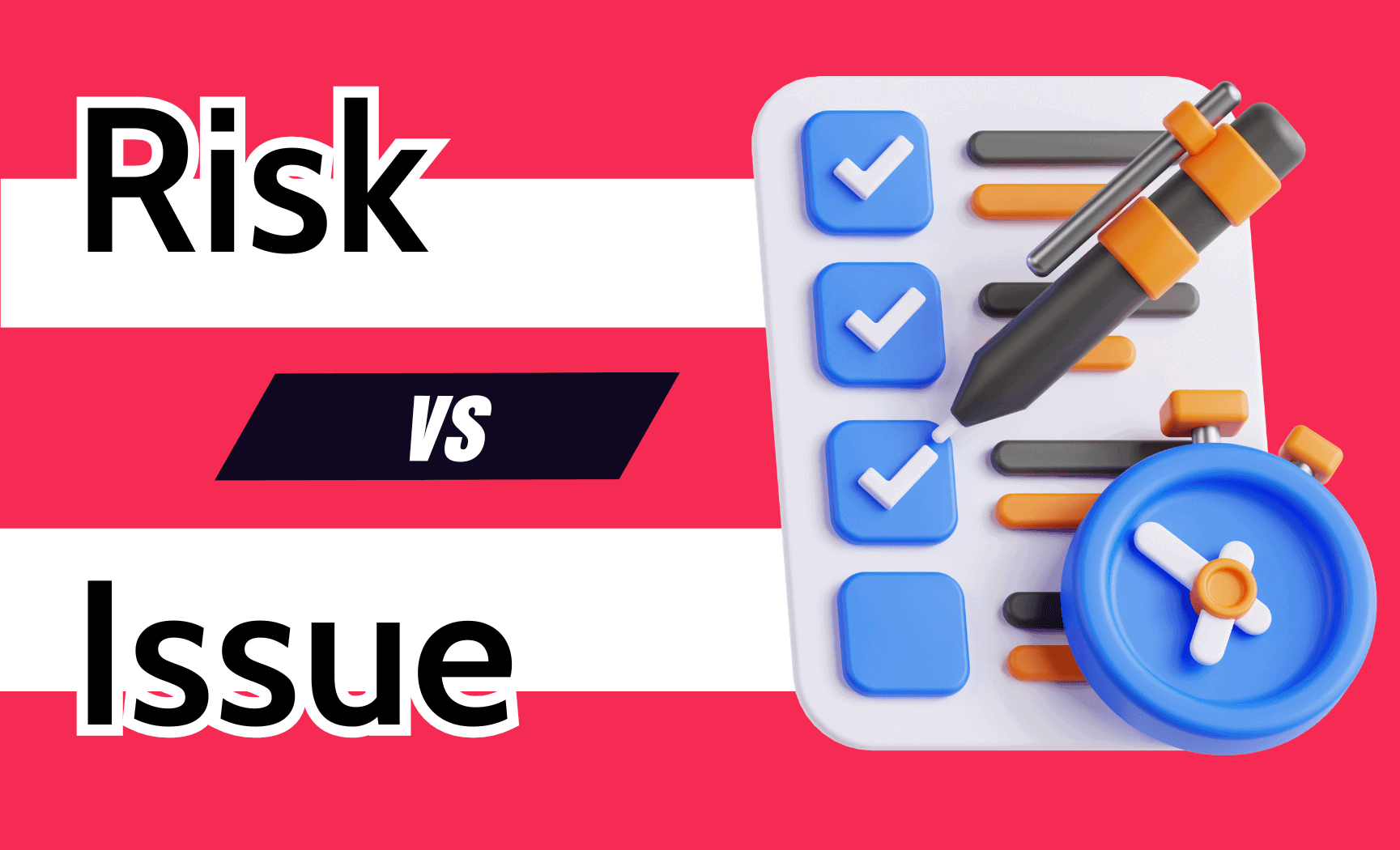
The terms “risk” and “issue” can be confusing in project management. At its core, a risk is an event that may negatively impact a project, while an issue is a problem actively affecting a project. However, this is just the surface — we’ll dive deeper into the differences between risk vs issue and offer guidance on the best project management software to help you navigate both.
Understanding the differences between these two fundamental concepts is essential for project managers to prevent potential problems from becoming major issues. If you’re looking for an affordable solution to help you stay on top of risks and issues, be sure to check out our cheap project management software roundup.
Learn more about our editorial team and our research process.
Risk vs Issue Compared at a Glance
A risk is a potential event that may happen in the future and could have a positive or negative effect on your project’s objectives. On the other hand, an issue is a problem that has already occurred and has a negative impact on the project. In other words, a risk is an issue that hasn’t materialized yet.
Though risks and issues are fundamentally different, they are closely related. If a risk develops and is not properly managed, it can turn into an issue. This is why it is critical to identify risks early on and proactively manage them before they become roadblocks to project success. We compare the key characteristics of risks and issues in the table below.
| Risk | Issue |
|---|---|
| Has not occurred yet | Has already occurred |
| Has a positive or negative impact | Typically has a negative impact |
| Identified through risk assessments | Identified through observation or monitoring |
| Tracked in risk registers | Documented in issue logs |
| Requires a proactive mitigation plan | Requires a reactive response and resolution |
The Importance of Understanding Issues and Risks
Identifying and managing both issues and risks in a project is crucial for successful project completion. Here are some key reasons why you should have a clear understanding of the differences between these two concepts:
- Prepare for potential risks: Effective project managers are proactive in identifying potential pitfalls that could hinder progress. This allows them to develop contingency plans to overcome these obstacles before they become major issues.
- Effectively allocate resources: Recognizing potential risks allows project managers to appropriately allocate resources such as time, budget and personnel. This ensures that the project team has adequate support, even when challenges arise. Check out monday.com or Trello for efficient resource management software.
- Improve decision-making: Understanding risks and issues leads to better project planning and decision-making. A project manager can weigh the possible outcomes and choose the best solution to overcome challenges.
- Foster continuous improvement: Documenting the lessons learned from risks and issues during sprint reviews and sprint retrospectives can help improve future or similar projects.
- Boost stakeholders’ confidence: Demonstrating a clear understanding of a project risk and issue can boost stakeholders’ confidence, as they see the identified risk being addressed proactively.

What Is a Risk in Project Management?
A risk in project management is defined as any potential uncertain incident that can have a positive or negative effect on a project. Early warning indicators are signs that a risk may be about to arise, including scope creep, budget overruns and external factors like market shifts or other unexpected events.
Though most risks are associated with potential negative outcomes, there are also positive risks that can improve a project’s efficiency and open up new opportunities. If you’re looking for software that can help manage risk, check out ClickUp. You can learn more about this project management software in our ClickUp review.

Types of Risks
Risks can take many forms, and a project manager must be aware of the various types that could have an impact on a project. Let’s take a look at some common risk categories.
What Is an Issue in Project Management?
Now that you understand what a risk in project management is, we will move on to what happens when a risk becomes an issue and how it impacts a project.
In project management, an issue is a current event that is impacting a project’s progress, scope, cost or quality. Issues require immediate attention and resolution to prevent future negative impacts or potential project failure.

Types of Project Management Issues
Just like risks, various types of issues can arise during a project. Here are some common categories.
Understanding the Risk Management Process
The risk management process is a structured method to identify, assess and mitigate risks throughout a project’s life cycle. This helps organizations proactively manage uncertainties and minimize the impact of such events.
Risk management is especially important for startups, which often face high uncertainty and volatility in the early stages of development. Adopting project management software for startups can help teams address potential risks. A good risk management plan should include:
- Risk identification: Identify early warning indicators of potential risks that could affect a new project by conducting brainstorming sessions, reviewing checklists and interviewing experts. Managers should document risks in a risk register or a risk log for future tracking and monitoring.
- Risk assessment: Evaluate the identified risks to determine the likelihood of occurrence and potential impact. This helps prioritize which risks require the most attention and mitigation effort.
- Risk response planning: Develop strategies and action plans to prevent risks from becoming issues or to reduce their negative impact.
- Risk monitoring and control: Continuously monitor and update risks in the risk register. Be sure to communicate any changes in risk status or the emergence of new risks to team members and stakeholders to ensure everyone is on the same page.
- Risk resolution: Implement planned response strategies and adapt them to changing circumstances as needed.
When Does a Risk Become an Issue?
A risk becomes an issue when it actually occurs and starts to negatively impact a project. This transition can happen suddenly or gradually, depending on the nature of the risk and the team’s risk management strategies. Once a risk becomes an issue, it requires immediate attention and action to mitigate the effects.
The Issue Management Process Explained
Issue management is the process of identifying, documenting, prioritizing and resolving problems to minimize their negative impact on a project. By proactively managing issues, a project manager can ensure the project stays on track and deliver the expected outcomes. This process typically involves the following steps:
- Issue identification: Document issues as they arise in team meetings, status reports or stakeholder feedback. Use an issue log or issue register to record each issue’s components, including a description, the impact and steps for resolution.
- Issue analysis: Analyze the identified issues for their root causes, urgency and necessary steps for resolution. Furthermore, teams should prioritize issues according to their impact on the project.
- Issue resolution: Develop and implement a plan to resolve the issues in the issue log. This may involve assigning responsibilities, allocating resources and setting a timeline for resolution.
Final Thoughts: The Difference Between Risk and Issue Summarized
Project managers deal with risks and issues daily. The first step to navigating them is to understand the main differences: timing and likelihood. Risks are potential problems that may occur in the future, whereas issues are current problems that are already affecting a project.
The best approach to managing both risks and issues is to proactively address risks before they become issues and to quickly resolve any issues that do materialize. Thanks to risk management, teams can get ahead of problems before they occur. When issues inevitably arise, an efficient issue management process enables teams to quickly resolve problems.
Now it’s your turn: What strategies have you found most effective for managing risks and issues in your projects? Have you encountered any challenges in managing them? Do you have any real-world examples to share? We’d love to hear your thoughts and experiences in the comment section below. Thank you for reading!
FAQ: Project Risk vs Issue
-
An issue is a problem that has already occurred, while a risk is a potential problem that may arise in the future. Issues are more urgent and require immediate action, whereas risks can be proactively managed to prevent them from becoming issues.
-
A risk can turn into an issue if it actually occurs and impacts the project objectives. At this point, the risk has become a current problem that needs immediate attention and resolution.
-
A risk that is effectively managed and does not materialize into a problem remains just a potential threat. However, it becomes an issue if it eventually occurs and affects the project.
-
Risks are identified through risk identification methods such as brainstorming sessions during daily meetings and stakeholder interviews. On the other hand, issues are identified through direct observation, status reports and monitoring activities.
{“@context”:”https://schema.org”,”@type”:”FAQPage”,”mainEntity”:[{“@type”:”Question”,”name”:”What Are the Key Differences Between an Issue and a Risk?”,”acceptedAnswer”:{“@type”:”Answer”,”text”:”
An issue is a problem that has already occurred, while a risk is a potential problem that may arise in the future. Issues are more urgent and require immediate action, whereas risks can be proactively managed to prevent them from becoming issues.n”}},{“@type”:”Question”,”name”:”Does a Risk Turn Into an Issue?”,”acceptedAnswer”:{“@type”:”Answer”,”text”:”
A risk can turn into an issue if it actually occurs and impacts the project objectives. At this point, the risk has become a current problem that needs immediate attention and resolution.n”}},{“@type”:”Question”,”name”:”Is a Risk Not an Issue?”,”acceptedAnswer”:{“@type”:”Answer”,”text”:”
A risk that is effectively managed and does not materialize into a problem remains just a potential threat. However, it becomes an issue if it eventually occurs and affects the project.n”}},{“@type”:”Question”,”name”:”How Do You Identify Risks and Issues?”,”acceptedAnswer”:{“@type”:”Answer”,”text”:”
Risks are identified through risk identification methods such as brainstorming sessions during daily meetings and stakeholder interviews. On the other hand, issues are identified through direct observation, status reports and monitoring activities.n”}}]}
The post The Difference Between Risk vs Issue Explained for Beginners in 2024 appeared first on Cloudwards.


